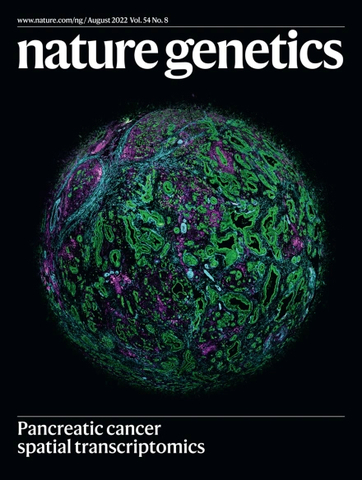Study Using NanoString’s GeoMx Digital Spatial Profiler Featured on the Cover of Nature Genetics
NanoString Technologies (NSTG) announced a significant advancement in pancreatic cancer research through a peer-reviewed paper published in Nature Genetics. This research utilized the GeoMx Human Whole Transcriptome Atlas to detail the molecular landscape of pancreatic cancer, showcasing innovations in precision oncology. The study highlights the tumor's cellular diversity and emphasizes how understanding malignant cell programs can enhance therapeutic strategies. The paper is featured on the cover of the August 2022 issue, demonstrating the platform's capability to refine oncology efforts against this challenging disease.
- Publication in Nature Genetics enhances company visibility and credibility.
- GeoMx technology showcased as critical for advancing precision oncology in pancreatic cancer.
- Research indicates potential for improved therapeutic strategies targeting specific cancer cell programs.
- None.
Insights
Analyzing...

A tissue image generated using
The paper, “Single-nucleus and spatial transcriptome profiling of pancreatic cancer identifies multicellular dynamics associated with neoadjuvant treatment,” was authored by a team led by
Since pancreatic cancer is one of the most challenging malignancies to treat with standard approaches, the research team sought to advance precision oncology strategies by understanding the molecular landscape of the multicellular subtypes and spatial communities of this cancer, including how they are remodeled after treatment.
The researchers used single-nucleus RNA sequencing (snRNA-seq) and digital spatial profiling with the GeoMx WTA to profile the tumors from a cohort of patients before or after neoadjuvant intervention. The snRNA-seq cell type signatures were used to deconvolve the GeoMx spatial profiles, demonstrating the complementarity of the two platforms. Together, the platforms demonstrated that malignant cells following different cellular programs (basal-like vs. classical-like) cluster in distinct immune niches within a tumor. The spatially-resolved transcriptomics analysis supported the hypothesis that basal-like malignant cell programs and classical-like programs drive different degrees of immune infiltration with distinct immune cell compositions and suggests that therapeutic strategies may be more effective if differentially targeted for these specific phenotypes.
“Since resistance to cytotoxic therapy is pervasive, there is a critical need to elucidate clinically-relevant gene expression programs and spatial relationships among malignant and stromal cells in the tumor microenvironment, particularly in residual disease,” said Hwang. “GeoMx spatial technology was critical in achieving this research objective because it allowed us to map our single-nucleus gene expression programs onto the tumor architecture with high fidelity (whole transcriptome) and in a cell-type specific manner (morphology antibody-based segmentation) and was optimized for FFPE samples, which is the specimen format that is most commonly available in the clinic. This unique combination of technological features enabled us to refine our understanding of the molecular taxonomy and spatial organization of PDAC that will ultimately advance precision oncology for this deadly disease.”
The high-resolution molecular framework sheds light on pancreatic cancer’s inter-and intra-tumoral diversity, spatial organization into discrete communities, treatment-associated remodeling, and clinically relevant prognostication. With these findings, researchers can harness this information to augment precision oncology efforts in pancreatic cancer and drive significant breakthroughs in oncology research.
About
Forward-Looking Statements
This news release contains forward-looking statements within the meaning of Section 27A of the Securities Act of 1933 and Section 21E of the Securities Exchange Act of 1934 and the Private Securities Litigation Reform Act of 1995. These forward-looking statements include statements regarding our products and the anticipated launch of new products and technology. Such statements are based on current assumptions that involve risks and uncertainties that could cause actual outcomes and results to differ materially. These risks and uncertainties, many of which are beyond our control, include market acceptance of our products; the extent and duration of the impact of the COVID-19 pandemic and adverse conditions in the general domestic and global economic markets; the effects of ongoing litigation; the impact of competition; the impact of expanded sales, marketing, product development and clinical activities on operating expenses; delays or other unforeseen problems with respect to manufacturing and product development; as well as the other risks set forth in our filings with the
View source version on businesswire.com: https://www.businesswire.com/news/home/20220809005149/en/
Vice President, Investor Relations & Corporate Communications
dfarrell@nanostring.com
Phone: 206-602-1768
Source:







